Powerdynamo brings new ignition & light
to your vintage motorcycle
|
Powerdynamo brings new ignition & light |
|||||
| assembly instructions for system 74 01 599 00 (CB350K) and 74 02 599 00 (CB450) |
Version 08.08.2012 |
|
If you can install your stock dynamo/alternator and
possess basic mechanical skills, you can install a Powerdynamo! |
|
| Powerdynamo can not monitor the compliance to those instructions, nor the conditions and methods of installation, operation, usage and maintenance of the system. Improper installation may result in damage to property and possibly even bodily injury. Therefore we assume no responsibility for loss, damage or cost which result from, or are in any way related to, incorrect installation, improper operation, or incorrect use and maintenance. We reserve the right to make changes to the product, technical data or assembly and operating instructions without prior notice. | |
|
|
Designated use This system is designated to replace stock ignition systems in vintage and classic motorcycles whose engine characteristics have not been modified aftermarket. This system is not a tuning system and it will not bring significant increases in engine output. It does however significantly enhance roadworthiness and road safety by offering increased reliability compared with the aging stock systems . As our systems do not tamper with engine characteristics they do not increase emission of gassous pollutants and noise. In most cases emission of pullutants should be even reduced due to better combustion. If used as designated the system therefore will not normally infringe the existing legal status of the motorcycle (this statement is valid for Germany, as this situation might be different in other countries, please consult your local road licencing regulations). This system is not suitable for use in competition events. If used other than designated warranty is voided and it might well be that you do not obtain the desired results. In worst cases use not in accordance with designated use might entail legal roadunworthiness. |
| Please read these instructions fully and carefully before starting work on your motorcycle. Please bear in mind that any modification of the material as well as own repair attempts which have not been agreed with Powerdynamo may result in a loss of warranty. Also, please take note of the information provided on the information page for this system. Check that what you have bought really corresponds to the motorcycle you have. Wrong ignition settings may damage your engine and even hurt you during kickstart (violent kickbacks). Be careful during the first test runs. If needed change settings to safer values (less advance). | |
| Please always use shielded spark plug caps (but not more than 5Kohm) with this system as the hall trigger element is very sensible and may catch the emission of a spark which can lead to ignition disturbances, even failure. | |
| Never place converter and advance unit (same housing) back to back, even as this might sound convenient. It can result in ignition failure, even destruction of material due to interference | |
| Our systems are NOT tested for use with other electronic devices (such as GPS, mobile phones, other 3rd party material.) and may cause damage to such parts. Possibly existing electronic tachometers will not work with the new system. Possibly existing safety switches and electronic valve controls are not supported. It might be that your motorcycle was originally equipped with an ignition that did limit top speed for legal reasons. The new system does not have such a facility, so check your legal situation beforehand | |
| If you have no expertise for the installation have it done by an expert or at a specialist's workshop. Improper installation may damage the new system and your motorcycle. | |
| If you have access to the Internet, best view those instructions online. You get larger and better pictures by clicking onto them and possibly updated information. System list at http://www.powerdynamo.biz | |
|
You may consult the wiring described below in graphic form in wire diagram 7412 (for twin spark 2 cylinder systems diagram 7422) |
|
|
|
|
| First, get to know the wires and plugs at the advance unit (labeled 74 00 52). | |
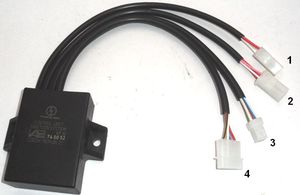
|
Here you have:
|
|
|
|
| Start with connecting the cable from hall-sensor unit to advance unit | |
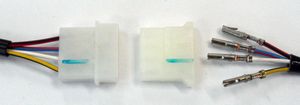
|
After you have ushered the wires from the hall-sensor through the tight opening at the points housing you put the flat 4 hole plug cover onto the wires from the hall sensor. Wire colours remain same. Both plug parts have some elevation to help orientation (we marked them green here for better visibility). Please double check that really colour connects to colour on both sides of the plug connection |
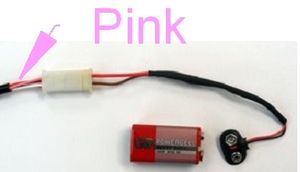
|
Identify the cable on the advance unit (pos 2 in overview picture)
which has a pink wire in it. You have received a cable called setup cable
with wires red and white. The plug on this cable matches the plug with the
pink wire. When you connect you match.
For setup please connect a battery 6 to 12V (may also be a 9V block as shown here). Red to plus, white to minus. Note: only for systems with negative ground! |
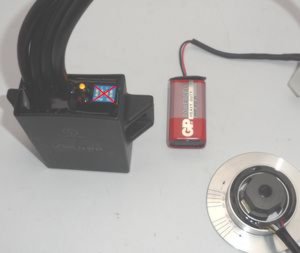
|
The hall unit shown here free on the table needs surely be fitted onto the
distributer at this moment. When you turn the hall rotor - still loosely
sitting on the distributer shaft and with the battery connected as
described - you will notice that at some point a diode starts shining,
than stops doing so until 180 degrees crankshaft turning further, the next does
the same. |
|
|
|
| Now you need to set basic timing. For this, the crankshaft has to be in a position in which the left piston (first igniting cylinder) is 50 degrees before top dead center (TDC). Those 50 degrees have nothing to do with any engine advance, they are just some internal reference the system needs. | |

|
With crankshaft in mentioned 50° position of first firing cylinder and
setup wire connected you slowly turn the hall rotor into its normal
rotation direction (that is anticlockwise) until the yellow diode
shines. The ignition coil fitted to the cable which contains a
yellow/black wire is the coil which is now destined to fire first.
Than slowly turn further into same direction until the diode so far
shining stops shining. In this position (with crank still at the
mentioned 50° situation) fasten the hall rotor on the shaft with the 2
small screws and the hex key. |
|
|
|
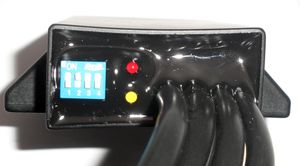
|
Setting the needed advance curve
is done by setting the 4 small switches in the blue switch block on the
advance unit as indicated below. |

|
With this setting OFF-OFF-ON-OFF ignition starts at 8° BTDC and retards
to 38° at 3000 revs/min. |
|
|
|
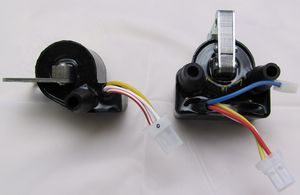
|
With this system you normally have 2 single exit ignition
coils (system 74 12 599 00), but you may - for twin spark in each
cylinder - also have 2 twin coils with 2 exists each (system
74 22 599 00). Each of the physical coils fires once per crankshaft
revolution, different one full revolution between the two. On the twin
coil, both exits fire at the same time.
The twin coil does have a short blue wire on it which in this configuration remains free (do not connect anything there!) |
|
|
|
| Take the setup cable off and connect the ignition coils as indicated above. | |
|
|
|
| Now, get to know the cables and plugs at the converter, labeled 7051. | |
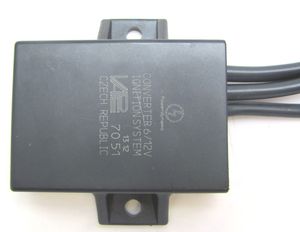
|
From the converter box come 3 wire bundles
|
|
|
|
| The cable with the open wires red and white: | is for connection to the battery. Connect the white to minus of the battery and the red to plus of the battery - via the main switch. Include a10A fuse and always run the wire via the main switch. Otherwise you can not stop the engine and you will drain your battery during longer standstills. |
|
|
|
 The
cable with the male 4 hole plug
... The
cable with the male 4 hole plug
...
|
... you connect to plug 3 of the advance unit.
colour matches colour.
|
|
|
|
 the
cable with the female 4 hole socket ... the
cable with the female 4 hole socket ...
|
... remains free (do not connect anything here, cover the plug with tape) |
|
Finally - and before you connect the battery- carefully
check again all wiring and fastening. |
|
|
|
|
|
|
Important safety and operating information |
|
# |
Safety first! Please observe the general health and safety regulations motor vehicle repair (MVR) as well as the safety information and obligations indicated by the manufacturer of your motorcycle. |
|
# |
Ignition systems generate high tension! With our material right up to 40,000 Volts! This may, if handled carelessly, not only be painful, but outrightly dangerous. Please do keep a safe distance to the electrode of your spark plug and open high tension cables. Should you need to test spark firing, hold the spark plug socket securely with some well insulating material and push it firmly to solid ground of the engine block. |
|
# |
After installation, please check tightness of all screws, even those preinstalled. If parts get loose during run, there will be inevitably damage to the material. We pre-assemble screws only loosely. |
|
# |
Give the newly installed system a chance to work, before you start
to check and test values, or what is worse is to apply changes to
customize the firing point before running the system. Our parts have been checked before delivery to you. You will not be able to check much anyway. At any rate do refrain from measuring the electronic components (such as ignition coil, regulator and advance unit). You risk severe damage to the inner electronics there. You will not get any tangible results from the operation anyway. Bear in mind that also your carburetor, your spark plugs and spark plug sockets (even if completely new) might be the reason for malfunction. The general experience with our systems is that the carburetor will have to be re-adjusted to lower settings. Should the system not start after assembly, first disconnect the blue cut-off wire directly at the ignition coil (or in some cases advance unit) to eliminate any malfunction in the cut-off circuitry. Check ground connections carefully. |
|
# |
The spark of classic, points based ignition systems has with about 10,000 Volts with little energy and looks therefore yellow and fat (hence it's visible). The spark from our system is a high energy spark with up to 40,000 Volts and therefore very sharp (needle thin focused) in form, and blue in colour, which makes it not so visible. Furthermore you get spark only at kickstart operated speeds and not by pushing the kick-lever down slowly with your hand (as you might get with battery based ignitions). |
|
# |
Systems using a twin outlet ignition coils have a few peculiarities. Please observe that during tests on one side, the other has either to be connected to an fitted spark plug or securely earthed/grounded. Otherwise there will be no spark on either side. |
|
# |
Never do electric arc welding on the bike without completely disconnecting all parts containing semiconductors (ignition coil, regulator, advance) stator and rotor need not be taken off. Never use copper putty on spark plugs. |
|
# |
Electronics are very sensitive to wrong polarity. After work on the system, do check correct polarity of the battery and the regulator. Wrong polarity creates short circuits and will destroy the regulator, the ignition coil and the advance unit. As a rule, wiring will always be colour to colour. Instances, where colour differs between wires it is expressly mentioned in our instructions. |
|
# |
Do not use spark plug sockets with a resistance of more than 5kOhm. Better use 1 or 2kOhm ones. Bear in mind that spark plug sockets do age and thereby increase their internal resistance. Should an engine start up only when cold, a defective spark plug socket and/or spark plug is very probably the cause. In case of problems check high tension cables too. Never use carbon fibre HT-cables, never use so called "hot wires" which promise to increase spark. |
|
# |
Should the motorcycle not be in use for some longer period, please disconnect the battery (so existing) to prevent current bleeding through the material. Though, even a disconnected battery will empty itself after a while. |
|
# |
Please do observe these remarks, but at the same
time, don't be afraid of the installation process. Remember, that before you, thousands of
other customers have successfully installed the system. Enjoy driving your bike with its new electric heart! |